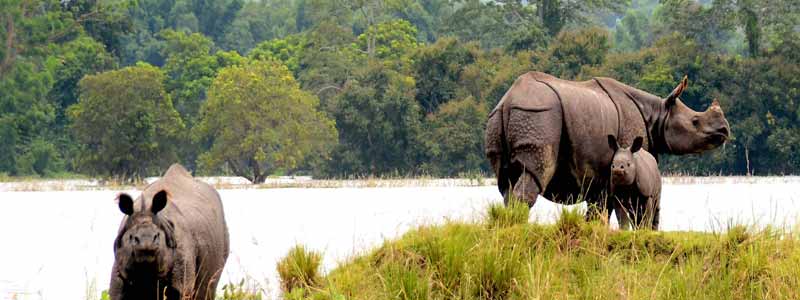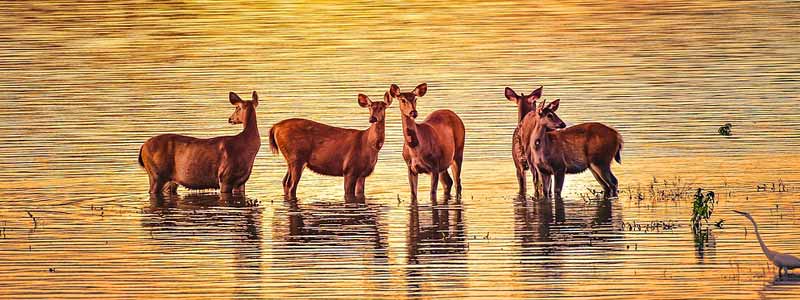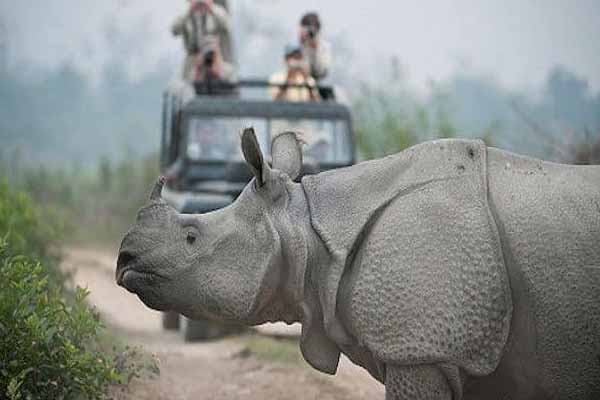A Complete Guide to Kaziranga National Park in the northeastern Indian state of Assam is an unqualified success. It has become the world’s largest refuge for the once critically endangered, greater one-horned rhino. Also known as the Indian rhino, this massive animal was pushed close to extinction at the end of the 20th century, as it was hunted for sport or killed as a pest. As recently as the 1970s, fewer than 200 animals remained yet today, the overall population stands at a (relatively) healthy 3,500, with a whopping two thirds of that number living in Kaziranga.
According to a census in 2018, 2,413 rhinos graze the grasslands and meadows of Kaziranga National Park, although this population could be even larger, with some animals evading the count in the tall grass. Unquestionably, in straight conservation terms, A Complete Guide to Kaziranga is a beacon park, with rhino numbers continuing to climb, but beneath this glowing picture lies numerous decisions that reveal the complex ethics surrounding animal conservation and wildlife tourism.

Safari Timings and Duration at The Kaziranga National Park
Elephant Safari- Elephant Safari starts early in the morning from 5:00 AM to 7:30 AM. Afternoon shift starts at 3:00 PM and ends at 4:00 PM. The safari lasts for 1-1.5 hours.
Jeep Safari- Jeep Safari is available in two shifts at Kaziranga National Park. Morning shift of the Jeep Safari starts from 7:00 AM and ends at 9:30 AM. Afternoon safari session starts from 1:30 PM and lasts till 3:30 PM. The duration of the safari is about 2-2.5 hours.

Safari Zones in Kaziranga National Park :-
Kohora (Central) Range : The Central Zone in the A Complete Guide to Kaziranga National Park is one of the core areas of the park and preferred zone for Jeep and Elephant ride. The probability of seeing Tiger, One-Horned-Rhinos, Wild buffalo and Swap Deer is high here.
Bagori (Western) Range : Bagori Ecotourism Range of the KNP is also known for for best wildlife sighting. The zone has the magnificently beautiful landscape with an abundance of wildlife species and lush greenery. Due to presence of water body (Pond) inside the Bagori attracts animals to quench their thrust. Most of the animals such as Rhino, Tiger and other species are easily sighted.
Agaratoli (Eastern) Range : Eastern side of the Kaziranga National Park along the national highway is Agaratoli Range. One Jeep Safari ride is permissible here. It is noted zone for wildlife photographers.
Burapahar (Ghorakati) Range : Burapahar is located around 40 kms from Central Range. The entry gate of this zone is located in the village of Ghorakati on the National Highway. It is known Zone for Jeep Ride, Elephant Ride and Trekking A Complete Guide to Kaziranga.
All the booking processes are fair and are solely decided by the forest officials. However, all the safari zones have the healthy and varied population of wildlife species and best for the wildlife sighting. The prime wild animals of A Complete Guide to Kaziranga forest like tigers, rhinos, elephants, wild buffalos, etc. are found equally in all the zones and their sightings are more or less same in all zones. The entire processes of the online booking for the Jeep Safari and Elephant Safari are managed by the forest officials using the automated computerized system to ensure the fair distribution of safari vehicles and tourism activities in all the zones.
Best Time to Visit Kaziranga National Park
The national park stays open from November to April for visitors and remains closed for the rest of the year as Brahmaputra River floods the park. If you want to spot rhinos and other animals like tiger and elephants, visiting during the months of March and April would be a great choice. The climate stays humid and hot during the day but the temperature decreases as the sun are close to setting.
The temperature varies from 7 degree Celsius to 37 degree Celsius in summers. Winter season, that is from November to January is a great option for bird watching as some rare migratory birds can be spotted here. During winter the climate stays mild and pleasant and ranges from 5 degree Celsius to 25 degree Celsius, A Complete Guide to Kaziranga.
How to Get to Kaziranga National Park
By air : –
The nearest airports to the park are the Guwahati International Airport and Jorhat Airport. Among the two, Jorhat is relatively closer at a distance of 97 km. There are also frequent public transport facilities available at Jorhat, so reaching the park or your stay wouldn’t be much of a chaotic task, A Complete Guide to Kaziranga.
Lokpriya Gopinath Bordoloi International Airport in Guwahati opts mostly as it has frequent flights connecting both domestically and internationally. From here, the Paltan Bazar bus stand is at a mere distance of 23 km from where you could find direct bus services to the park. In case this seems inconvenient, there are also numerous cab services that can be availed as well.
By Train :-
Furkating station, located 96 km from the park, has well-connected networks from Delhi, Kolkata, Guwahati and so on.
The Jorhat railway station and Guwahati station are farther away than Furkating with a distance beyond 100-200 km.
Since the park is located right in the midpoint on the route to Tezpur and Jorhat, it’s easier to reach the place by cabs and other means of transport.
By Road :-
The park is connected via NH37 to many of the major cities including Guwahati, Jorhat, Golaghat, Shivsagar and so on.
Guwahati to Kaziranga – 176 km
Shivsagar to Kaziranga – 170 km
Jorhat to Kaziranga – 113 km
Golaghat to Kaziranga – 89 km
There are also well-maintained road links to Kolkata, Delhi, Patna and so on. There are very frequent public transport services available to the town of Kohora. In intervals between the state transport bus timings, there’s private run buses, minibuses and cabs that go en route, A Complete Guide to Kaziranga.
